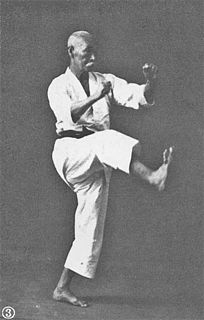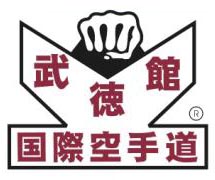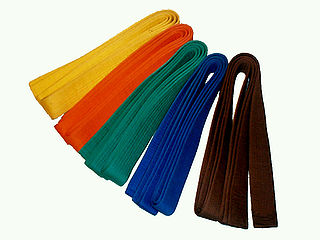 W
WKarate (空手) is a martial art developed in the Ryukyu Kingdom. It developed from the indigenous Ryukyuan martial arts under the influence of Kung Fu, particularly Fujian White Crane. Karate is now predominantly a striking art using punching, kicking, knee strikes, elbow strikes and open-hand techniques such as knife-hands, spear-hands and palm-heel strikes. Historically, and in some modern styles, grappling, throws, joint locks, restraints and vital-point strikes are also taught. A karate practitioner is called a karateka (空手家).
 W
WChitō-ryū (千唐流) is a style of karate founded by Dr. Tsuyoshi Chitose , (1898-1984). The name of the style translates as: chi (千) - 1,000; tō (唐) - China; ryū (流) - style, school, "1,000 year old Chinese style." The character tō (唐) refers to the Tang Dynasty of China. The style was officially founded in 1946.
 W
WGosoku-ryū (剛速流) is a style of karate which was founded by Takayuki Kubota. Gosoku stands for hard and fast, which suggests a combination of techniques both from the fast and dynamic Shōtōkan style as well as from the strength-focused Gōjū-ryū style.
 W
WHojo undō (補助運動) is a Japanese language term, translated as "supplementary exercises", that refers to conditioning exercises used in martial arts, especially in Karate. Hojo undō training was designed to develop ambidextrous physical strength, stamina, muscle coordination, speed, and posture. This style of training uses simple, traditional devices made from wood and stone.
 W
WMany Japanese martial arts feature an obi as part of their exercise outfit. Such an obi is often made of thick cotton and is about 5 cm wide. The martial arts obi are most often worn in the koma-musubi knot ; in practice where a hakama is worn, the obi is tied in other ways.
 W
WKarategi is the formal Japanese name for the traditional uniform used for Karate practice and competition.
 W
WKata is a Japanese word meaning "form". It refers to a detailed choreographed pattern of martial arts movements made to be practised alone. It can also be reviewed within groups and in unison when training. It is practised in Japanese martial arts as a way to memorize and perfect the movements being executed. Korean martial arts with Japanese influence use the derived term hyeong and also the term pumsae.
 W
WKumite is one of the three main sections of karate training, along with kata and kihon. Kumite is the part of karate in which a person trains against an adversary, using the techniques learned from the kihon and kata.
 W
WThe makiwara (巻藁) is a padded striking post used as a training tool in various styles of traditional karate. It is thought to be uniquely Okinawan in origin. The makiwara is one form of hojo undō, a method of supplementary conditioning used by Okinawan martial artists.
 W
WMotobu-ryū (本部流) is a school of karate founded by Choki Motobu in 1922. The official full name is Nihon Denryu Heiho Motobu Kenpo.
 W
WShindo Jinen Ryu (神道自然流) is a form of karate that was founded in 1933 by Yasuhiro Konishi .
 W
WOkinawa Karate-Dō Shōrin-ryū Kishaba Juku, also called, familiarly, Kishaba Juku, is Chokei Kishaba's private academy of the Matsubayashi-ryu style of Okinawan Karate. The Kishaba Juku was officially founded on February 1, 1998, but had been in existence as an informal karate study group since the late 1970s.
 W
WShōrinjiryū Kenkōkan Karate (少林寺流拳行館唐手) is a style of karate founded by Kōri Hisataka (1907–1988) shortly after World War II in Japan.
 W
WShorinjiryu Koshinkai Karatedo (少林寺流古新会唐手道) is a school of karate based on the Shōrinjiryū Kenkōkan Karatedo lineage of Kōri Hisataka, as passed on by two of the leading students of the founder, Masayuki Hisataka of Shorinjiryu Kenkokan and Shunji Watanabe of Shorinjiryu Kenyukai Watanabe-Ha. Shorinjiryu Koshinkai Karatedo was jointly founded by Jim Griffin, Max Estens, Lesley Griffin and Des Paroz in Australia. Shorinjiryu Koshinkai Karatedo is the school of karate taught by the Australian Shorinjiryu Karatedo Association, the original Australian school of Shōrinjiryū Kenkōkan Karate, founded in 1977.
 W
WWadō-ryū (和道流) is one of the four major karate styles and was founded by Hironori Otsuka (1892-1982). The style itself places emphasis on not just striking, but tai sabaki, joint locks and throws. It has its origins within Tomari-te karate, but also gains influence from Shito-Ryu and Shotokan, however it was massively influenced by JiuJitsu, which explains the emphasis on concepts such as tai sabaki, noru and nagashi sabaki.
 W
WYoseikan Karate (養正館空手) or Yoseikan Ryu Karate (養正館流空手) is the name given to the variant of Shotokan Karate taught at the Yoseikan Dojo in Shizuoka, Japan, under the direction of Minoru Mochizuki.